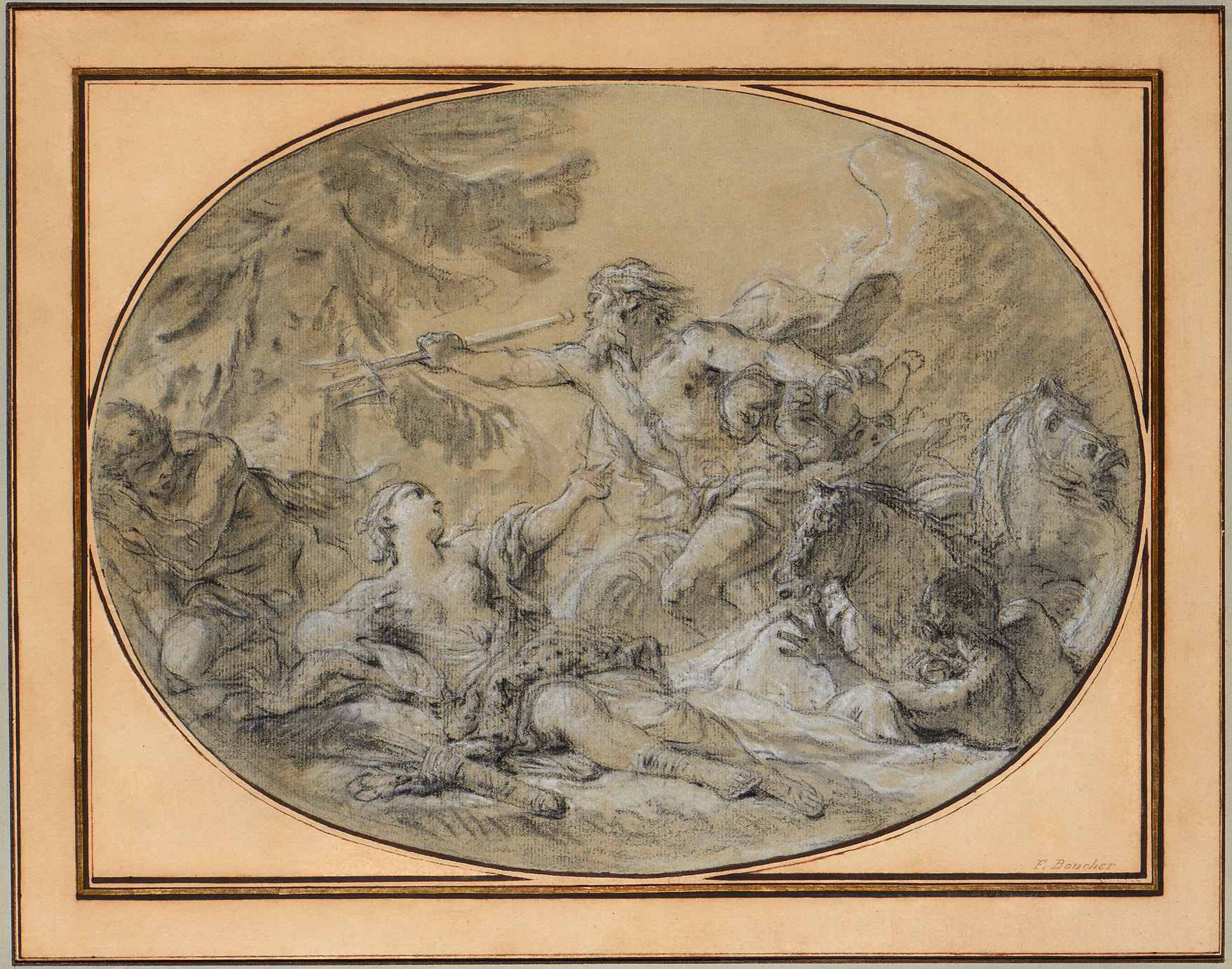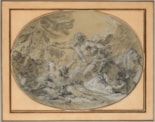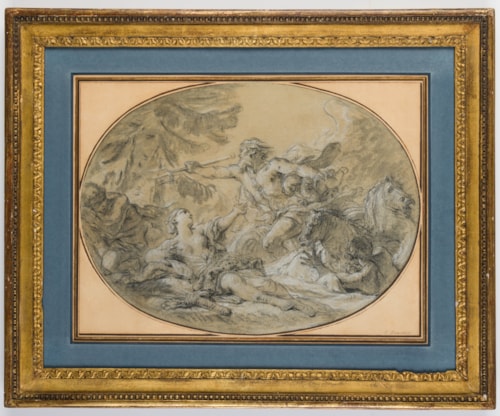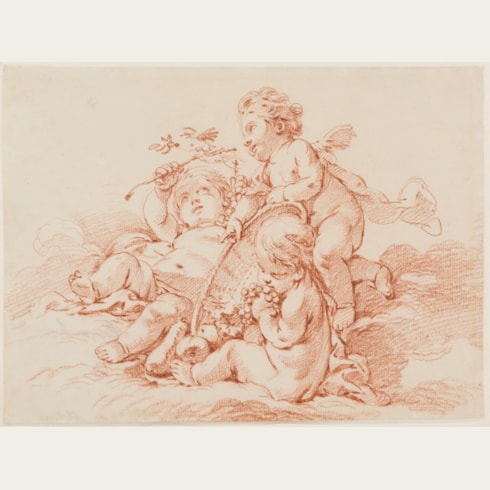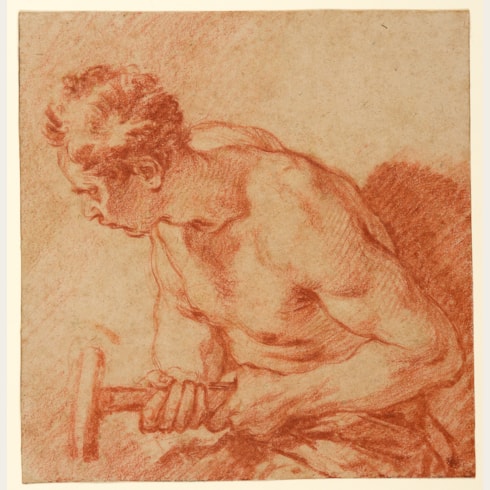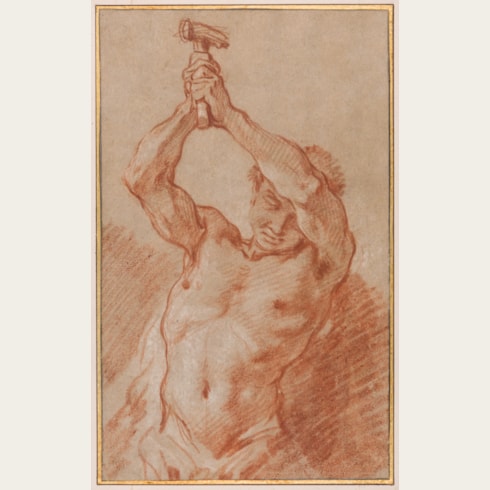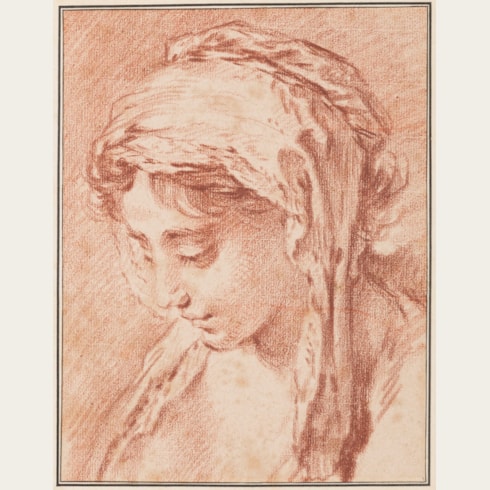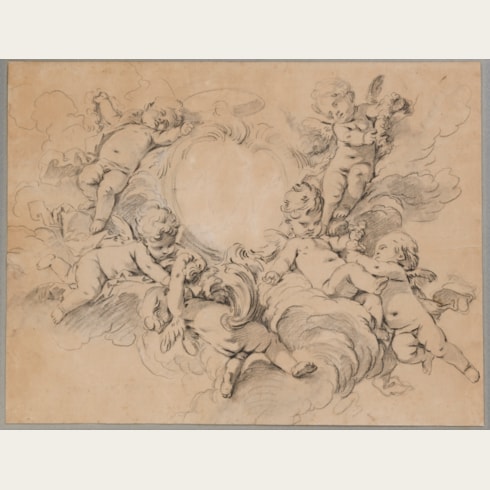François BOUCHER
(Paris 1703 - Paris 1770)
Neptune Rescuing Amymone
Oval.
Laid down on an 18th century French mount, with the blind stamp of the mountmaker Jean-Baptiste Glomy (Lugt 1085) applied twice, once near the lower right corner of the mount and again in the centre, just below the bottom of the oval composition.
Inscribed F. Boucher near the lower right corner of the mount.
278 x 375 mm. (11 x 14 3/4 in.)
These four paintings by Boucher were in turn used for the central medallions of a set of tapestries ordered in 1763 from the Gobelins manufactory by George William, 6th Earl of Coventry, for a room in his country seat at Croome Court in Worcestershire, which was in the process of being remodelled by the architect Robert Adam. Commissioned by the Earl of Coventry from the master weaver Jacques Neilson, the head of the Gobelins workshop, these tapestries depicted simulated paintings of subjects from Ovid’s Metamorphoseshung upon imitation crimson damask grounds. The tapestries, symbolizing the four Elements, comprised two upright ovals of Aurora and Cephalus and Vertumnus and Pomona, representing allegories of Air and Earth, respectively, and a pair of transverse or horizontal ovals depicting Venus Visiting Vulcan (Fire) and Neptune Rescuing Amymone (Water). Boucher’s oval compositions were inserted into the tapestry designs as central medallions with fictive frames, to which were added elaborate decorative borders (alentours) designed by Maurice Jacques. As Alastair Laing has pointed out, ‘[Boucher’s] oval compositions, both upright and transverse, were only commissioned once the end of the Seven Years war, and the visit [to Paris] of the 6th Earl of Coventry, enabled Jacques Neilson, using Boucher and Maurice Jacques, to put into effect his plans for a set of tapestries with simulated framed paintings on simulated damask grounds with ornamental borders, that he had been proposing since 1758.’ Woven between 1764 and 1771 for Croome Court, this first set of the so-called Tentures de Boucher, today adorns a room from that house in the Metropolitan Museum of Art in New York.
Boucher kept a studio at the Gobelins tapestry factory from 1749, and between 1755 and 1765 served as surinspecteurat the manufactory. He produced a number of paintings to be copied as tapestries at the Gobelins, the most significant of which to survive are the Tentures de Boucher. As Laing has noted, ‘Right up to the end of his life Boucher was producing paintings – not always of mythological subjects – for successive sets of the Tentures de Boucher, almost all of which were commissioned by grand foreign – and particularly English – clients; and this was continued after his death, based upon paintings that he had left behind. They were amongst the most successful sets of tapestries ever woven at the Gobelins.’ Related to the central medallion of the tapestry of Neptune Rescuing Amymone, the present sheet, which may be dated to 1764, depicts the sea god Neptune, armed with his trident, leaping from his horse-drawn chariot to save Amymone from the ravages of a satyr.
Boucher had earlier treated the theme of Neptune and Amymone in a tapestry design for the Beauvais manufactory of 175010, although this was different in composition to the present sheet and the version of the subject in the Tentures de Boucher. The painting which served as the model for the 1750 tapestry is lost, although a preparatory drawing by Boucher, with considerable differences from the tapestry, is in the Louvre.
Appointed a professor at the Académie Royale in 1735, Boucher painted numerous easel pictures – pastoral landscapes, religious and mythological subjects, genre scenes, chinoiseries and portraits – for private clients in France, Sweden, Denmark, Germany and Poland, while also producing several tapestry cartoons for the Beauvais and Gobelins manufactories, where he succeeded Jean-Baptiste Oudry as inspecteur des ouvrages in 1755. He designed stage sets and costumes for the Opéra and the Opéra-Comique in the 1740s and created designs for Vincennes and later Sèvres porcelain throughout the 1750s and early 1760s. In 1765 Boucher was named premier peintre du roi, or First Painter to the King, and also appointed director of the Académie Royale. In 1770 he died at his lodgings in the Louvre and was buried in the church of Saint-Germain l’Auxerrois. Among his pupils were Jean-Baptiste Deshays and Pierre-Antoine Baudouin, both of whom became his sons-in-law and predeceased him, as well as Jean-Honoré Fragonard, Jean-Baptiste Le Prince and Gabriel-Jacques de Saint-Aubin.
A gifted draughtsman, François Boucher was as prolific as he was talented, and claimed to have produced ten thousand drawings over a career that lasted some fifty years. He was, in fact, perhaps the most prolific French draughtsman of the eighteenth century, and his drawn oeuvre includes pastoral scenes, nudes, religious, historical and mythological subjects, book illustrations, chinoiseries, landscapes, genre scenes, studies of children and heads, as well as designs for tapestries, porcelain and fountains. Although most of his drawings were preparatory studies for his paintings, Boucher also produced finished drawings as independent works, often adapting and elaborating a head or figure from one of his paintings. While his preference was for black, red, and (particularly in his later years) a dark brown chalk, he also made highly finished drawings in pastel and, at times, drew on coloured paper. As Pierre Rosenberg has succinctly noted, ‘Boucher’s love of drawing never waned with time and success. Admittedly, drawing was kept in its proper place, as a vital link between the conception or the idea of a work or composition, and its realization, its metamorphosis into a painting…To quote Mariette, Boucher “was a born painter”, but he placed great emphasis on drawing throughout his entire career.’ Boucher’s drawings were avidly collected in his lifetime by such connoisseurs as Barthelémy-Augustin Blondel d’Azaincourt, Paul Randon de Boisset, Pierre-Jacques-Onésyme Bergeret de Grancourt, Gilbert Paignon-Dijonval, Jean-Claude Gaspard de Sireuil, Count Carl Gustaf Tessin, and many others.
Boucher's drawn oeuvre includes all manner of subjects, including pastoral scenes, nudes, religious, historical and mythological subjects, book illustrations, chinoiseries, landscapes, nudes, genre scenes, studies of children and heads, as well as designs for tapestries, porcelain and fountains. He produced many finished drawings as independent works, often adapting and elaborating a head or figure from one of his paintings. While his preference was for black, red, and (particularly in his later years) brown chalk, Boucher also made highly finished drawings in pastel and, at times, drew on coloured paper. A large number of his drawings were finished works for collectors and the art market, and many were engraved and reproduced in considerable numbers – often making use of new printmaking techniques that allowed chalk drawings to be reproduced with a high degree of verisimilitude - by such printmakers as Louis-Marin Bonnet, Gilles Demarteau or Gabriel Huquier. His drawings were greatly admired, and while many were preparatory studies for his paintings, others were produced as finished works of art, to be sold to collectors or reproduced by engravers. Indeed, Boucher’s popularity as a draughtsman owes much to the fact that many of his drawings were reproduced and widely distributed as engravings.
Provenance
His posthumous sale, Paris, Place des Victoires, Hôtel de Menars, 18 March 1782 onwards, part of lot 289 (‘L’Aurore & Céphale, & la Colere de Neptune. Ces deux morceaux sont aux crayons noir & blanc, sur papier bleu.’, both sold framed for 91,2 livres)
Veil-Picard collection, Paris
Anonymous sale, Paris, Artcurial, 19 June 2007, part of lot 21 (sold for €73,113)
Wildenstein, New York.
Literature

